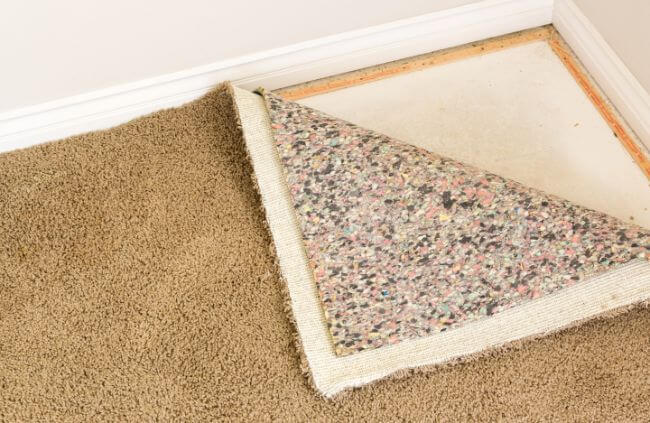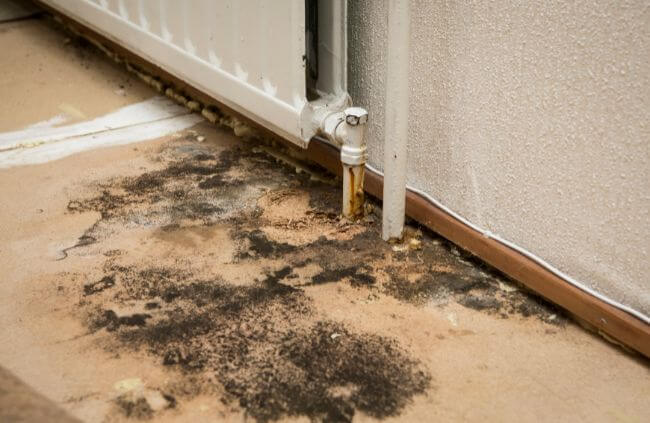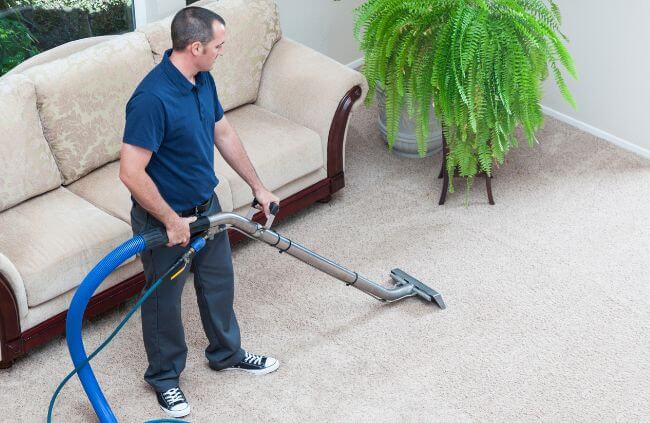Mould on carpet is not only an eyesore, but also a health hazard. If left untreated, mould spores can spread throughout your home. Not only will they affect your carpet, but also other surfaces in your house. They can also cause respiratory issues and other health problems for those with compromised immune systems.
In this article, we will discuss the practical methods for safely and effectively removing mould on carpet. We will also explore the causes of carpet mould, signs to look out for, and steps you can take to prevent it from coming back.
What Causes Mould on Carpet?

Carpet mould usually occurs when moisture gets trapped in the carpet fibres. This moist environment is perfect for growing mould. Humidity can be especially high in areas like bathrooms, kitchens, and basements. This makes these rooms prone to carpet mould if not properly ventilated and maintained.
Another common cause of mouldy carpets is poor ventilation. Rooms with little to no airflow trap moisture, making it harder for carpets to dry out completely.
Trapped moisture allows mould spores, which are naturally in the air, to settle into the carpet and multiply. Over time, these spores grow into visible mould patches, often producing a musty smell and discolouring the carpet fibres.
Without proper ventilation or drying, mould will spread quickly. This makes it a lot more difficult to remove. As it spreads, it can cause carpet damage and stubborn stains while releasing dangerous spores that may lead to respiratory issues. The faster you address the problem, the easier it will be to eradicate the mould issue.
Why is There Black Stuff on My Carpet
New mould infestations are often invisible to the naked eye. But after a while you will see the discolouration caused by the mould. Here are some signs that you have mould on carpet.
Musty Odours
A strong, musty smell is often the first sign of mould. This stale odour is often more noticeable in poorly ventilated areas.
Discolouration
Mould can cause green, brown, or black stains on your carpet. These stains may spread over time. It is important that you address any strange spots right away. Perform a thorough inspection to make certain you addressed every spot.
Allergy Symptoms
If you or someone in your family experience allergy symptoms, mould may be the culprit. Common symptoms include sneezing, itchy eyes, coughing, nasal congestion, and skin irritations.
These symptoms can worsen when the individual is in the infected room. For some, mould exposure can be a serious issue that leads to a hospital visit.
If you notice any of these signs of mould on carpet, it is vital that you deal with the situation immediately. Ignoring signs of mould can lead to worsening symptoms and even structural damage to your floors.
Addressing the underlying cause right away not only helps save your carpet but also prevents potential health risks. Dealing with the problem early can save you from full carpet replacement.
Why is Mould Growing on My Carpet?
Carpets can be a breeding ground for mould. This is especially true in areas where there is high humidity. Mould thrives in dark, damp environments. Once they get into the carpet fibres, they can quickly multiply.
When moisture remains in carpets, it creates the perfect environment for mould to grow. Wet carpet in bathrooms, kitchens, basements, and rooms with poor ventilation are extremely susceptible.
Even a small spill or leak can lead to mould growth if it is not cleaned up and dried immediately. Over time, these spores move deeper into the carpet and spread quickly.

Is Mould on Carpet Dangerous?
Yes, both white mould and black mould on carpet can pose health risks, especially for individuals with weakened immune systems. While black mould is generally more toxic and can lead to severe respiratory issues, white mould can still trigger allergic reactions and cause discomfort.
Mould spores can easily settle into carpet fibres and begin to spread. Once mould spores are present, they can become airborne. This makes them easy to inhale. The spores can then trigger allergic reactions, such as itchy eyes, and even cause severe respiratory issues.
Mould can often be found in humid areas like bathrooms, basements, and rooms with poor ventilation. When moisture remains trapped in carpets, it creates an ideal environment for mould growth.
Even the smallest amount of moisture can lead to mould spreading deep into the carpet fibres. Once mould spores settle, they can quickly take over, making it difficult to eliminate without thorough cleaning.
Over time, this mould growth can compromise the integrity of the carpet and your flooring. Not only are the stains unsightly, mould also creates unpleasant odours.
As mould spreads, it not only damages the carpet but also raises health risks. Individuals exposed to mould may experience symptoms like coughing, sneezing, and asthma attacks.
Addressing mould growth promptly is essential to maintain a safe, healthy living environment. Left untreated, mould can continue to spread, damaging carpets and potentially affecting other surfaces in your home.
Can Mouldy Carpet Be Saved?
In some instances, you can save your carpet. This will all depend on how much damage the mould has caused. If the mould is in a very small area, you can often clean it up with simple household items like baking soda, vinegar, or hydrogen peroxide.
Spot cleaning and using a steam cleaner can also kill the mould without harming the carpet. At Myer Carpet Cleaning, we will do everything we can to stop mould from coming back.
However, if mould covers a large portion of the carpet, it might be best to replace it. A mould infestation can damage the carpet fibres and spread to the carpet underlay. This makes it hard to remove carpet mould completely.
How to Remove Mould from Carpet
Here are some safe and effective methods for mould carpet cleaning. You should already have most of these cleaning products in your cabinet:
1. Baking Soda and Vinegar
Baking soda and vinegar are natural mould removers and are safe for most carpets. This solution is great for light mould growth and can help deodorise your carpet.
- Sprinkle a generous amount of baking soda on the affected area.
- Spray white vinegar over the baking soda. Let it work its magic for about 10 minutes.
- Scrub the area with a stiff brush. Then blot it with a clean cloth to remove moisture. Make sure to wear gloves to protect your hands.
- Run a hepa vacuum over the area once it is dry to remove any remaining mould spores.
2. Hydrogen Peroxide
Hydrogen peroxide is a powerful mould remover. However, it should be used with caution because it can bleach your carpet.
- Mix one part hydrogen peroxide with three parts water in a spray bottle.
- Spray the solution onto the mouldy area and let it sit for 10–15 minutes.
- Blot the area with a cloth, then rinse with clean water. Blot again to remove moisture. Make sure to wear gloves to protect your hands.
- Run a hepa vacuum over the area once it is dry to remove any residue.
3. Steam Carpet Cleaning
For more severe mould infestations, consider carpet steam cleaning. The high temperatures can kill mould on contact. Using a steam cleaner is the best method for mould removal.
4. Use a Commercial Carpet Cleaner
If the above methods do not work, give Myer Carpet Cleaning a call. We can effectively remove mould on carpet with steam cleaning and 100% environmentally friendly products.

Preventing Mould Spores on Carpet
Once you have successfully removed either black or white mould on carpet, take these steps to inhibit mould growth:
Control Humidity
Use dehumidifiers, especially in basements or other humid areas where there is excess moisture. Dehumidifiers help reduce the overall humidity in the air, making it harder for mould to grow and spread.
Fix Leaks Immediately
Address any plumbing leaks immediately. Even small leaks can cause major issues. Fixing leaks promptly prevents water from seeping into carpet and padding, where mould can thrive. Regularly inspect pipes, faucets, and under-sink areas to catch leaks early.
Vacuum Regularly
Regular vacuuming removes dust and other particles that can encourage mould growth. These particles can trap moisture which creates the perfect environment for mould spores to multiply. For the best results, use a vacuum with a HEPA (High-Efficiency Particulate Air) filter to capture fine particles and allergens.
Allow Sunlight and Fresh Air In
Open windows and let the sunlight in. Sunlight is a natural mould deterrent. The sun’s UV rays help to kill mould and reduce moisture levels. Allowing fresh air and sunlight into your home can create a less hospitable environment for mould growth.
Should Mouldy Carpet Be Replaced
In many cases, where mould has spread extensively, your carpet will need to be replaced. Mould can damage the carpet fibres and the carpet underlay. This makes it very difficult to clean it thoroughly. A heavily damaged, mouldy carpet can lead to health issues like allergies and respiratory problems.
However, if only a small area of the carpet is affected, the best course of action is to have it professionally cleaned. Natural remedies can work well for mould removal on smaller areas. But if the mould has spread, call a professional carpet cleaner. At Myer Carpet Cleaning we can save your carpet while saving you money.
Replacing your carpet due to mould has its pros and cons. While replacing the carpet will take care of your mould problem, it comes with a higher upfront cost. Cleaning is a lot cheaper, but it may not fully resolve severe mould problems.
Safely Remove Mould on Carpet for a Healthier Home
Removing mould on carpet may seem scary, but with the right methods you can tackle it safely and save your carpet. From using household items like baking soda and vinegar to hiring Myer Carpet Cleaning, you can tackle your carpet cleaning needs.
At Myer Carpet Cleaning, we use eco-friendly, non-toxic products that are safe for your family and pets. Our experienced team removes mould on carpet and targets the mould that has penetrated your carpet.
